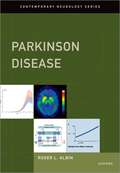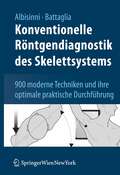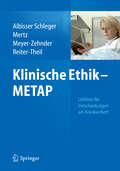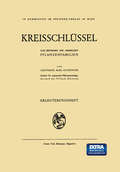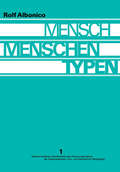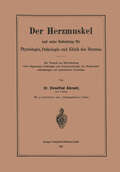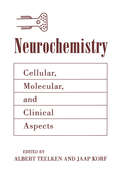- Table View
- List View
Parkinson Disease (CONTEMPORARY NEUROLOGY SERIES)
by Roger L. AlbinParkinson Disease is a comprehensive introduction to the biology and clinical features of Parkinson disease (PD). This book is aimed at clinicians in training, general neurologists seeking a useful guide to PD, and scientists seeking an overview of clinical aspects of PD. Topics covered include nosology of PD, PD epidemiology, pathology and pathophysiology of PD, and theories of PD pathogenesis. Clinical features, including the many non-motor features, natural history of disease progression, clinical pharmacology, and management of PD receive coverage. Important themes are heterogeneity of PD, the multi-focal nature of PD pathology, the diversity of clinical features, dopaminergic signaling and the impacts of dopaminergic deficiency, the importance of non-motor features, limitations of existing treatment modalities, and the necessity of approaching PD as a multi-system disorder. The description and discussion of the many aspects of Parkinson disease (PD) is dogged by the fact that PD is an ambiguous concept. This book intends to be a useful overview, bridging the gap between general textbooks and specific topical reviews.
Konventionelle Röntgendiagnostik des Skelettsystems: 900 moderne Techniken und ihre optimale praktische Durchführung
by Ugo Albisinni Milva Battaglia24 Kapitel schildern rund 900 Aufnahmetechniken, die im letzten Jahrhundert an diversen Schulen und in verschiedenen Ländern entwickelt wurden. Einfach und einheitlich beschreiben die Autoren alle Einstellungen und illustrieren sie anhand einer schematischen Zeichnung. Diese Vorgehensweise erleichtert Anwendern das Verständnis und die unmittelbare Durchführung. Jede Beschreibung enthält wichtige anatomische Markierungen zur Vereinfachung der komplexen Strukturen radiologischer Untersuchungen. Für jede Einstellung geben die Autoren die genauen technischen Parameter an. Ein internationaler und systematischer Überblick im handlichen Format.
Klinische Ethik - METAP: Leitlinie für Entscheidungen am Krankenbett
by Heidi Albisser Schleger Marcel Mertz Barbara Meyer-Zehnder Stella Reiter-TheilTherapieentscheidungen lösen in klinischen Teams häufig Unsicherheiten und Konflikte aus, insbesondere wenn es um schwerkranke Patienten geht. Fallen Entscheidungen vornehmlich situationsgeleitet, sind bestimmte Patientengruppen einem Risiko der Unter-, Über- oder Ungleichversorgung ausgesetzt. Der Metap-Leitfaden unterstützt Ärzte, Pfleger und Therapeuten daher in ihrer ethisch reflektierten Entscheidungskompetenz mit verschiedenen Orientierungs- und Entscheidungsinstrumentarien. Diese berücksichtigen eine gerechte Zuteilung der Ressourcen.
Monoclonal Antibodies: Methods and Protocols (Methods in Molecular Biology #378)
by Maher AlbitarThis book examines a collection of state-of-the-art methods that employ monoclonal antibodies in a clinical setting. The chapters offer in-depth description for generating mouse and recombinant humanized antibodies, and a comprehensive review of how antibodies are being used in bead-based methods for measuring proteins. This field will continue to expand and provide new and innovative techniques in the laboratory and as a basis that complements targeted therapy.
Visual Guide to Neonatal Cardiology
by Ernerio T. Alboliras Ziyad M. Hijazi Cecilio Leo Lopez Donald J. HaglerThe Visual Guide to Neonatal Cardiology is a comprehensive, highly illustrated, reference covering the evaluation, diagnosis and management of cardiac disease in the newborn. Contains over 900 color illustrations, including patient photographs, chest roentgenograms, electrocardiograms, echocardiograms, angiocardiograms, 3D computed tomogramphy, magnetic resonance imaging, pathologic specimens, and other relevant visual aids Discusses the natural history of fetal heart disease and the rationale, indications, technique, and impact of fetal cardiac intervention Reviews the anatomy and physiology of the neonatal cardiovascular system, including differences within the fetal, transitional, neonatal, child and adult circulatory system Highlights key steps for taking a patient history, including detailed discussion of the cardiac examination (inspection, palpation and auscultation of heart sounds and murmurs) Presents over 35 morphologic conditions with sections covering introduction, epidemiology, etiology with accepted or postulated embryogenesis, pathophysiology, clinical presentation, physical examination findings, diagnostic evaluation, management, and prognosis Includes a neonatal formulary reviewing selected medications currently used for treatment of perioperative low cardiac output, congestive heart failure, pulmonary hypertension, sedation, pain and anticoagulation in neonates
Visual Guide to Neonatal Cardiology
by Ernerio T. Alboliras Ziyad M. Hijazi Leo Lopez Donald J. HaglerThe Visual Guide to Neonatal Cardiology is a comprehensive, highly illustrated, reference covering the evaluation, diagnosis and management of cardiac disease in the newborn. Contains over 900 color illustrations, including patient photographs, chest roentgenograms, electrocardiograms, echocardiograms, angiocardiograms, 3D computed tomogramphy, magnetic resonance imaging, pathologic specimens, and other relevant visual aids Discusses the natural history of fetal heart disease and the rationale, indications, technique, and impact of fetal cardiac intervention Reviews the anatomy and physiology of the neonatal cardiovascular system, including differences within the fetal, transitional, neonatal, child and adult circulatory system Highlights key steps for taking a patient history, including detailed discussion of the cardiac examination (inspection, palpation and auscultation of heart sounds and murmurs) Presents over 35 morphologic conditions with sections covering introduction, epidemiology, etiology with accepted or postulated embryogenesis, pathophysiology, clinical presentation, physical examination findings, diagnostic evaluation, management, and prognosis Includes a neonatal formulary reviewing selected medications currently used for treatment of perioperative low cardiac output, congestive heart failure, pulmonary hypertension, sedation, pain and anticoagulation in neonates
Intraventricular Conduction Disturbances (Developments in Cardiovascular Medicine #12)
by A. AlboniRhythm was the first expression of cardiac activity which fell under man's obser vation, and the heart beat has always represented the very essence of life itself as it accelerates or slows during moments of rest, effort, joy and pain until it comes to a halt at the moment of death. Undoubtedly the heart beat was, for a considerable time, the only semiological element by which man could interpret the dysfunctions of the organism. Even after thousands of years, research into the alterations of cardiac rhythm still holds a certain fascination, although modern methods and sophisticated devices have changed the approach to such studies. Only about ten years ago, the in terpretation of arrhythmias was obtained by a standard electrocardiogram to which experimental findings on animals were still arbitrarily applied. On the other hand, the achievement of diagnostic decisions was of little importance outside the sphere of pure intellectual speculation since valid therapeutical treatments were lacking. At present, by means of electrophysiological investigations, one can verify and check 'in situ' the different forms and mechanisms through which rhythm and conduction disorders are manifested. Thus, achieving such a methodology which may be defined as a 'functional biopsy', we are allowed to put forward more accurate therapeutic indications now available using both pharmacological and electrical treatment.
Vasovagal Syncope
by Paolo Alboni Raffaello FurlanThis book is exceptional in being devoted solely to vasovagal syncope (VVS), the most frequent cause of transient loss of consciousness in the general population. All aspects of VVS are covered, including epidemiology, pathophysiology, diagnosis and differential diagnosis, prognosis, therapy and implications for particular activities such as work, driving and physical activity. The context for the book is that about half of the population suffer from this type of loss of consciousness during their lifetime and then often call for general practitioner and/or emergency room assistance. While many pathophysiological aspects of VVS have been clarified, others remain elusive. The diagnosis of VVS may be easy, but it is sometimes challenging. From the therapeutic standpoint, few evidence-based therapies have been established and the large majority of treatments remain unsatisfactory. Vasovagal Syncope presents the latest evidence on all these issues and will be of value for internists, cardiologists, neurologists, emergency physicians and general practitioners.
Mensch, Menschen, Typen: Entwicklung und Stand der Typenforschung; Ergebnisse einer Gemeinschaftsarbeit aus dem Humanbiologischen Seminar der Hochschule St. Gallen mit Unterstützung durch das Forschungsinstitut der Eidgenössischen Turn- und Sportschule Magglingen
by Rolf Albonico Eidgenössische Turn- und SportschuleHistological Typing of Tumours of the Gallbladder and Extrahepatic Bile Ducts (WHO. World Health Organization. International Histological Classification of Tumours)
by Jorge Albores-Saavedra D.E. Henson Leslie H. SobinIn collaboration with pathologists in 5 countries
Real-Time Monitoring of Cancer Cell Metabolism for Drug Testing
by Hamed AlborziniaHamed Alborzinia uses the biosensor chip to monitor the metabolic and morphological changes in cancer cell lines in real time, particularly: (i) real-time measurements of basic cancer cell metabolism of different cancer cell lines; (ii) a detailed timeline of the metabolic response to cisplatin treatment and clear detection of the time span between start of cisplatin treatment and onset of cell death, which reflects the time required for the underlying molecular mechanisms of cell fate decision; (iii) direct functional measurement of the biological activity of a key regulatory protein of cellular metabolism following the kinetic change in respiration upon SIRT3 overexpression; and (iv) the time-resolved impact of several organometallic compounds on cell metabolism and cell morphology, including unexpected and not yet understood highly significant and specific effects on cell-cell interaction and adhesion.
Dermatologie an der Schwelle zum neuen Jahrtausend: Aktueller Stand von Klinik und Forschung
by D. Albrecht C. Hattendorf T. LorenzenDieser Band beinhaltet die Beiträge des wissenschaftlichen Programms der 40. Tagung der Deutschen Dermatologischen Gesellschaft. Im Vorfeld wurden bereits klare thematische Schwerpunkte gesetzt, die eine Standortbestimmung der Dermatologie in Deutschland erlauben. Die Themen unterstreichen die Bedeutung der Dermatologie für die gesamte Medizin. Die Anforderungen des niedergelassenen Hautarztes wurden ebenso berücksichtigt.
Handbuch Changemanagement im Krankenhaus: 20-Punkte Sofortprogramm für Kliniken (Erfolgskonzepte Praxis- & Krankenhaus-Management)
by D. Michael Albrecht Armin TöpferDie Herausforderung für Kliniken besteht heute darin, sich schnell zu verändern und sich nachhaltig zu entwickeln mit dem Ziel, mehr Leistung zu erbringen – bei besserer Qualität und geringerem Aufwand. International tätige Experten bieten in dem Band ihr Erfahrungswissen, ihre Lösungen und Daten an, um notwendige Veränderungen erfolgreich managen zu können. Die Neuauflage wurde komplett überarbeitet und u. a. um Themen wie Outsourcing und Logistik erweitert. Der Band enthält eine Checkliste mit über 130 Fragen zum 15-Punkte-Sofortprogramm.
Recognition of Pattern and Form: Proceedings of a Conference Held at the University of Texas at Austin, March 22–24, 1979 (Lecture Notes in Biomathematics #44)
by Duane G. AlbrechtDer Herzmuskel und seine Bedeutung für Physiologie, Pathologie und Klinik des Herzens: Ein Versuch zur Entwickelung einer allgemeinen Pathologie und Symptomatologie der Herzmuskelerkrankungen auf anatomischer Grundlage
by Ehrenfried AlbrechtNeurochemistry: Cellular, Molecular, and Clinical Aspects
by Jan Albrecht Stefan Bröer Piet Eikelenboom Antonio Guiditta Jerzy W. Lazarewicz Konrad Löffelholz Rona R. Ramsey Rupert Schmidt Keith F. TiptonProceedings of the 11th European Society for Neurochemistry Meeting held in Groningen, The Netherlandes, June 15-20, 1996
Erfolgreiches Changemanagement im Krankenhaus: 15-Punkte Sofortprogramm für Kliniken
by Michael Albrecht Armin TöpferGesundheitswesen im Umbruch! Krankenhäuser überleben heute nur, wenn die zentralen Anforderungen an das Management innovativ umgesetzt werden. Hierzu gehören neben einem hohen medizinischen Qualitätsstandard in gleichem Maße auch Kostentransparenz, Prozessoptimierung und eine hohe Zufriedenheit von Patienten, Angehörigen, Kostenträgern und Einweisern. Eine Lösung für die effektive Umsetzung dieser widersprüchlichen Ziele bietet das 15-Punkt-Sofortprogramm: - Alle wesentlichen Instrumente werden anhand eines 15-Punkte Schemas eingeordnet und dargestellt - Ein strukturierter Ablaufplan bietet sowohl operative, kurzfristig greifende Maßnahmen als auch strategisch langfristigen Handlungsmöglichkeiten. Zusätzlich: - Flussdiagramme veranschaulichen jeden einzelnen Prozessschritt - Beispiele aus der Praxis erläutern die Umsetzung - Eine Checkliste am Ende jeden Kapitels verschafft den Überblick Holen Sie sich das konzeptionelle Rüstzeug für die Anwendung im eigenen Aufgaben bereich von Experten und Praktiker auf dem Gebiet der Betriebswirtschaftslehre und des Krankenhausmanagements!
Clinical Aspects of Sensory Motor Integration (Advances in Applied Neurological Sciences #4)
by Albrecht Struppler and Adolf WeindlThe ability to use tools skillfully is generally regarded as one of the major achievements in the evolutionary development of the human nervous system. It is possible for controlled movements of muscles to be executed only if sensory information is integrated into complex neural circuits at various hierarchical levels. The chapters in this volume deal with basic and clinical aspects of integrative processing of sensory and motor activities. New findings emphasize the important influence of somatosensory activity such as tactile, proprioceptive, noxious cutaneous, and articular input on motor output. Furthermore, recordings of evoked potentials as well as unit recordings indicate that sensory and cortical activities are highly interrelated. Control of muscles by motoneurons is exerted both electrically and chemically. Disturbed muscle-motoneuron interaction is reflected in ultrastructural motoneuron morphology and may be of importance in the pathogenesis of motoneuron disease. Long loop reflex testing under various pathological conditions provides insight into disturbed sensory motor circuitry in humans. Electrophysiological recording as well as neurochemical and im munohistochemical studies elucidate the neural circuitry of basal ganglia and their neural connections, thus providing improved therapeutic concepts. The role of the thalamus and thalamocortical connections in sensory motor processing is of particular interest, because motor disturbances such as tremor or dystonia can be effectively relieved by stereotaxic interventions at the subthalamic or thalamic level.
Contrast-Enhanced Ultrasound in Clinical Practice: Liver, Prostate, Pancreas, Kidney and Lymph Nodes
by Thomas Albrecht Lars Thorelius Luigi Solbiati Luca Cova Ferdinand FrauscherThe Circadian Clock (Protein Reviews #12)
by Urs AlbrechtWith the invitation to edit this volume, I wanted to take the opportunity to assemble reviews on different aspects of circadian clocks and rhythms. Although most c- tributions in this volume focus on mammalian circadian clocks, the historical int- duction and comparative clocks section illustrate the importance of various other organisms in deciphering the mechanisms and principles of circadian biology. Circadian rhythms have been studied for centuries, but only recently, a mole- lar understanding of this process has emerged. This has taken research on circadian clocks from mystic phenomenology to a mechanistic level; chains of molecular events can describe phenomena with remarkable accuracy. Nevertheless, current models of the functioning of circadian clocks are still rudimentary. This is not due to the faultiness of discovered mechanisms, but due to the lack of undiscovered processes involved in contributing to circadian rhythmicity. We know for example, that the general circadian mechanism is not regulated equally in all tissues of m- mals. Hence, a lot still needs to be discovered to get a full understanding of cir- dian rhythms at the systems level. In this respect, technology has advanced at high speed in the last years and provided us with data illustrating the sheer complexity of regulation of physiological processes in organisms. To handle this information, computer aided integration of the results is of utmost importance in order to d- cover novel concepts that ultimately need to be tested experimentally.
Erbbiologie und Erbpathologie körperlicher Zustände und Funktionen II: Vierter Band (Psychologie - Reprint #4)
by W. Albrecht K.H. Bauer R. Degkwitz K. Diehl H. Euler M. Gänsslen K. Gutzeit E. Hanhart T. Kemp H. Kirchmair F. Kröning K. Lambrecht W. Lehmann R. Lotze R. RitterDieser Buchtitel ist Teil des Digitalisierungsprojekts Springer Book Archives mit Publikationen, die seit den Anfängen des Verlags von 1842 erschienen sind. Der Verlag stellt mit diesem Archiv Quellen für die historische wie auch die disziplingeschichtliche Forschung zur Verfügung, die jeweils im historischen Kontext betrachtet werden müssen. Dieser Titel erschien in der Zeit vor 1945 und wird daher in seiner zeittypischen politisch-ideologischen Ausrichtung vom Verlag nicht beworben.
Anatomie. Entwicklungsgeschichte. Physiologie. Untersuchungsmethoden (Handbuch der Hals-, Nasen-, Ohrenheilkunde mit Einschluß der Grenzgebiete #1-5 / 1)
by W. Albrecht R. Beneke H. Brunner C. v. Eicken K. El?e K. Graupner L. Grünwald H. Koenigsfeld L. Küpferle E. Mangold M. Nadolec?ny A. Passow K. Peter R. Schilling S. Schumacher A. Seiffert E. v. Skramlik A. Thost G. Wet?el C. ?arniko H. ?waardemakerDieser Buchtitel ist Teil des Digitalisierungsprojekts Springer Book Archives mit Publikationen, die seit den Anfängen des Verlags von 1842 erschienen sind. Der Verlag stellt mit diesem Archiv Quellen für die historische wie auch die disziplingeschichtliche Forschung zur Verfügung, die jeweils im historischen Kontext betrachtet werden müssen. Dieser Titel erschien in der Zeit vor 1945 und wird daher in seiner zeittypischen politisch-ideologischen Ausrichtung vom Verlag nicht beworben.
Rechtsfragen der Obduktion und postmortalen Gewebespende (MedR Schriftenreihe Medizinrecht)
by Albrecht Wienke, Markus A. Rothschild and Kathrin JankeBei über 95 % aller Verstorbenen in Deutschland bestehen nach wie vor keine autoptisch gesicherten Erkenntnisse über die eigentliche Todesursache und etwaige Begleiterkrankungen. Die auf einer solchen unsicheren Datenlage beruhenden gesundheitspolitischen Entscheidungen zu Disease-Management-Programmen, zu Prävention und strukturellen Maßnahmen der Krankenversorgung entsprechen damit nicht der erforderlichen Evidenz. Dies hat zugleich negative Auswirkungen auf die Qualität ärztlicher Diagnostik und Therapie und somit auf die Patientensicherheit. Zudem machen es die sehr unterschiedlichen Rechtsgrundlagen in den Landesgesetzen über das Leichen-, Bestattungs- und Friedhofswesen den betroffenen Angehörigen und den Mediziner in der praktischen Umsetzung der oft widerstreitenden Interessen nicht leicht. Die klinische und anatomische Sektion ist nach derzeit allgemeiner Meinung auch im wissenschaftlichen Interesse oder zu Ausbildungszwecken ohne Zustimmung des Verstorbenen oder seiner Angehörigen unzulässig. Die medizinische Forschungs- und Ausbildungssituation wird durch diese Zustimmungslösung nachhaltig beeinträchtigt; eine erweiterte Widerspruchslösung könnte hierbei viele Hindernisse in der praktischen Handhabung beseitigen. Die DGMR hat sich in ihren aktuellen Empfehlungen daher für eine gesetzliche Abkopplung der postmortalen Gewebespende von der Organtransplantation im Transplantationsgesetz ausgesprochen, um die seit Jahren niedrige Obduktionsquote in Deutschland nachhaltig zu verbessern. Der vorliegende Tagungsband gibt die Referate und die Empfehlungen der DGMR zur Obduktion und postmortalen Gewebespende wieder.
